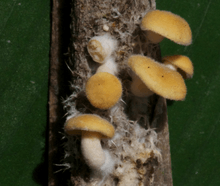Lactifluus
| Lactifluus | |
|---|---|
 | |
| Lactifluus piperatus | |
| Scientific classification | |
| Kingdom: | Fungi |
| Division: | Basidiomycota |
| Class: | Agaricomycetes |
| Order: | Russulales |
| Family: | Russulaceae |
| Genus: | Lactifluus (Pers.) Roussel (1806) |
Lactifluus is a genus of mushroom-producing fungi. It is one of three genera containing species commonly named milk-caps, the others being Lactarius and Multifurca. It has been separated from Lactarius based on molecular phylogenetic evidence and is very similar to that genus. Lactifluus species have a mainly tropical distribution, but are also found in the north temperate zone as well as Australia and New Zealand.
Systematics and taxonomy
| ||||||||||||||||||
| Phylogenetic relationships of Lactarius, Lactifluus, Multifurca, and Russula.[1] |
The genus Lactifluus was described in 1806 by French naturalist Henri François Anne de Roussel, with the type species Lactifluus piperatus.[2] Later, Lactifluus was largely considered a synonym of Lactarius, until molecular phylogenetic work showed in 2008 that Lactarius was not a monophyletic group.[1] In the following, the name Lactarius was conserved for the biggest of the subclades revealed, containing most well-known north temperate species.[3][4][5] Thus, the name Lactifluus could be used for the smaller genus, necessitating only a few name changes, as combinations with Lactifluus had already been made previously for many temperate species.[3][6] New combinations have since been proposed for several species formerly classified in Lactarius.[7][8][9]
Description

Lactifluus closely resembles its lookalike genus Lactarius, with whom it shares the brittle flesh of the fruit bodies and the milk-like latex exuded when bruised. So far, synapomorphic characters for the genus have not been discovered, there are only tendencies that distinguish it from Lactarius.[6] Pleurotoid (laterally stiped) fruitbodies are only known in Lactifluus, while species with closed (angiocarpous) fruitbodies only occur in Lactarius.[6] Microscopically, thick-walled elements in the pileipellis and stipitipellis (cuticle of the stipe) and sphaerocytes in the trama of the lamellae are common in Lactifluus, but rare in Lactarius species.[6]
Edibility

Several species in the genus are edible. Lactifluus volemus especially is a choice mushroom in the northern temperate region.[10]
Species (selection)
North temperate zone
- Lactifluus corrugis – 'corrugated-cap milky'
- Lactifluus deceptivus – 'deceiving milk-cap'
- Lactifluus hygrophoroides
- Lactifluus piperatus – 'peppery milk-cap'
- Lactifluus vellereus – 'fleecy milk-cap'
- Lactifluus volemus – 'weeping milk-cap' or 'voluminous-latex milky'
Tropical regions
- Lactifluus aureifolius
- Lactifluus densifolius
- Lactifluus edulis
- Lactifluus heimii
- Lactifluus madagascariensis
- Lactifluus neotropicus
Australasia
- Lactifluus clarkeae
- Lactifluus leonardii
- Lactifluus wirrabara
See also
References
- ↑ 1.0 1.1 Buyck B, Hofstetter V, Eberhardt U, Verbeken A, Kauff F. (2008). "Walking the thin line between Russula and Lactarius: the dilemma of Russula sect. Ochricompactae" (PDF). Fungal Diversity 28: 15–40.
- ↑ Roussel HFA. (1806). Flore du Calvados et terrains adjacents, composée suivant la méthode de Jussieu (in French). Caen: L.-J. Poisson. p. 66. Retrieved 2014-10-19.
- ↑ 3.0 3.1 Buyck B, Hofstetter V, Verbeken A, Walleyn R. (2010). "Proposal to conserve Lactarius nom. cons. (Basidiomycota) with conserved type". Taxon 59: 447–453.

- ↑ Barrie F. (2011). "Report of the General Committee: 11". Taxon 60 (4): 1211–1214.

- ↑ Norvell LL. (2011). "Report of the Nomenclature Committee for Fungi: 16". Taxon 60: 223–226.

- ↑ 6.0 6.1 6.2 6.3 Verbeken A, Nuytinck J. (2013). "Not every milkcap is a Lactarius" (PDF). Scripta Botanica Belgica 51: 162–168.
- ↑ Stubbe D, Wang X-H, Verbeken A. (2012). " "New combinations in Lactifluus. 2. L. subg. Gerardii". Mycotaxon 119: 483–485. doi:10.5248/119.483.
- ↑ Verbeken A, Nuytinck J, Buyck B. (2012). "New combinations in Lactifluus. 1. L. subgenera Edules, Lactariopsis, and Russulopsis". Mycotaxon 118: 447–453. doi:10.5248/118.447.
- ↑ Verbeken A, Van de Putte K, De Crop E. (2012). "New combinations in Lactifluus. 3. L. subgenera Lactifluus and Piperati". Mycotaxon 120: 443–450. doi:10.5248/120.443.
- ↑ Bessette AR, Bessette A, Harris DM. (2009). Milk Mushrooms of North America: A Field Identification Guide to the Genus Lactarius. Syracuse, New York: Syracuse University Press. p. 5. ISBN 0-8156-3229-0.
External links
- Lactifluus in Index Fungorum.
- Lactifluus in MycoBank.